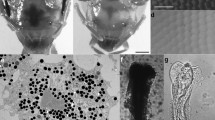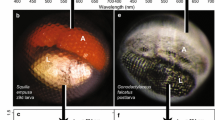Abstract
-
1.
Morphological correlates of circadian changes in eye sensitivity to light measured electrophysiologically were sought in the cockroach, Leucophaea maderae. Cross sections of ommatidia removed at subjective midday and subjective midnight on 3 successive days from roaches held under constant darkness (DD) at 25 ± 2 °C were examined using a transmission electron microscope for morphological differences related to sampling time.
-
2.
The temporal difference in submicrovillar cisternae (SMC) area appeared to exhibit a circadian rhythm, however, the amplitude of this temporal difference measured under DD was less than that observed under LD 12∶12 conditions. SMC areas characteristic at nighttime were achieved at subjective midnights but the area diminished only partially toward the daytime state on subjective middays.
-
3.
Rhabdom area remained constant and the daily rhythm of screening pigment granules (SPG) arrangement about the rhabdom was not observed under conditions of constant darkness.
-
4.
Results of this study indicate that a pacemaker(s) actively influences the change in the SMC toward the nighttime state, whereas, the change toward the daytime state results from a passive mechanism that possibly could be accelerated by light.
Similar content being viewed by others
Abbreviations
- SMC:
-
submicrovillar cisternae
- SMD:
-
subjective midday
- SMN:
-
subjective midnight
- SPG:
-
retinula cell screening pigment granules
References
Arikawa K, Morikawa Y, Suzuki T, Eguchi E (1988) Intrinsic control of rhabdom size and rhodopsin content in the crab compound eye by a circadian biological clock. Experientia 44:219–220
Barlow RB Jr (1983) Circadian rhythms in the Limulus visual system. J Neurosci 3:856–870
Barlow RB Jr, Bolanowski SJ Jr, Brachman ML (1977) Efferent optic nerve fibers mediate circadian rhythms in the Limulus eye. Science 197:86–89
Barlow RB Jr, Chamberlain SC, Levinson JZ (1980) Limulus brain modulates structure and function of the lateral eyes. Science 210:1037–1039
Barlow RB Jr, Kaplan E, Renninger GH, Saito T (1985) Efferent control of circadian rhythms in the Limulus lateral eye. Neurosci Res, Suppl 2:S65-S78
Baumann O, Walz B (1989) Calcium- and inositol polyphosphatesensitivity of the calcium-sequestering endoplasmic reticulum in the photoreceptor cells of the honeybee drone. J Comp Physiol A 165:627–636
Bernard GD, Owens ED, Hurley AV (1984) Intracellular optical physiology of the eye of the pyralid moth Amyelois. J Exp Zool 229:173–187
Blest AD (1988) The turnover of phototransducive membrane in compound eyes and ocelli. Adv Insect Physiol 20:1–53
Blest AD, Stowe S (1990) Dynamic microvillar cytoskeleton in arthropod and squid photoreceptors. Cell Motility Cytoskeleton 17:1–5
Butler R (1973) The anatomy of the compound eye of Periplaneta americana L. 2. Fine structure. J Comp Physiol 83:239–262
Chamberlain SC, Barlow RB Jr (1979) Light and efferent activity control rhabdom turnover in Limulus photoreceptors. Science 206:361–363
Chamberlain SC, Barlow RB Jr (1987) Control of structural rhythms in the lateral eye of Limulus: Interactions of natural lighting and circadian efferent activity. J Neurosci 7:2135–2144
Colwell CS, Page TL (1989) The electroretinogram of the cockroach Leucophaea maderae. Comp Biochem Physiol 92A: 117–123
Colwell CS, Page TL (1990) A circadian rhythm in neural activity can be recorded from the central nervous system of the cockroach. J Comp Physiol A 166:643–649
Ferrell BR, Reitcheck BG (1990) Daily changes in ommatidia morphology in the cockroach, Leucophaea maderae. Trans Ky Acad Sci 51:26–31
Fleissner G (1982) Isolation of an insect circadian clock. J Comp Physiol 149:311–316
Frixione E, Ruiz L (1988) Calcium uptake by smooth endoplasmic reticulum of peeled retinal photoreceptors of the crayfish. J Comp Physiol A 162:91–100
Goldsmith TH, Bernard GD (1974) The visual system of insects. In: Rockstein M (ed) The physiology of Insecta, 2nd edition, Vol. II. Academic Press, New York, pp 165–272
Horridge GA, Duniec J, Marcelja L (1981) A 24-hour cycle in single locust and mantis photoreceptors. J Exp Biol 91:307–322
Kass L, Barlow RB Jr (1992) A circadian clock in the Limulus brain transmits synchronous efferent signals to all eyes. Visual Neurosci 9:493–504
Kass L, Pelletier JL, Renninger GH, Barlow RB Jr (1988) Efferent neurotransmission of circadian rhythms in Limulus lateral eye. II. Intracellular recordings in vitro. J Comp Physiol A 164:95–105
Kier CK, Chamberlain SC (1990) Dual controls for screening pigment movement in photoreceptors of the Limulus lateral eye: circadian efferent input and light. Visual Neurosci 4:237–255
Lavialle M, Chabanet C, Dumortier B (1989) The 24-h rhythm of metabolic activity of the cockroach arcadian pacemaker. Neurosci Lett 105:86–90
Mote MI, Goldsmith TH (1983) Spectral sensitivities of color receptors in the compound eye of the cockroach Periplaneta. J Exp Zool 173:137–146
Nishiitsutsuji-Uwo J, Pittendrigh CS (1968) Central nervous system control of circadian rhythmicity in the cockroach III. The optic lobes, locus of the driving oscillation. Z Vergl Physiol 58:14–46
Page TL (1984) Neuronal organization of a circadian clock in the cockroach Leucophaea maderae. In: Porter RP, Collins GM (eds) Photoperiodic regulation of insect and molluscan hormones. Ciba Foundation Symposium 104, Pitman, London, pp 115–135
Page TL (1987) A circadian rhythm in vitro recorded from the optic lobe of the cockroach. Soc Neurosci Abstr 13:49
Page TL (1989) Circadian organization and the representation of circadian information in the nervous systems of invertebrates. Adv Biosci 73:67–79
Page TL (1990) Circadian organization in the cockroach. In: Huber I, Masler EP, Rao BR (eds) Cockroaches as models for neuro-biology: applications in biomedical research. Vol. II. CRC Press, Inc. Boca Raton, Florida, pp 225–208
Page TL, Larimer JL (1975) Neural control of circadian rhythmicity in the crayfish, II: The ERG amplitude rhythm. J Comp Physiol 97:81–96
Pak WL, Shortridge RD (1991) Inositol phospholipid and invertebrate photoreceptors. Photochem Photobiol 53:871–875
Payne R (1986) Phototransduction by microvillar photoreceptors of invertebrates: mediation of a visual cascade by inositol triphosphate. Photobiochem Photobiophys 13:373–397
Payne R, Fein A (1987) Inositol 1,4,5-triphosphate releases calcium from specialized sites within Limulus photoreceptors. J Cell Biol 104:933–937
Payne R, Walz B, Levy S, Fein A (1988) The localization of calcium release by inositol triphosphate in Limulus photoreceptors and its control by negative feedback. Phil Trans R Soc Lond B 320:359–379
Schwemer J (1984) Renewal of visual pigment in photoreceptors of the blowfly. J Comp Physiol A 154:535–547
Snyder AW (1979) The physics of vision in compound eyes. In: Autrum H (ed) Vision in Invertebrates. Handbook of sensory physiology VII/6A. Springer, Berlin Heidelberg New York pp 225–313
Toh Y (1990) Diurnal structural changes in rhabdomeric microvilli of the compound eye in the blue crab, Callinectes sapidus. Zool Sci 7:961–965
Tomioka K, Chiba Y (1992) Characterization of an optic lobe circadian pacemaker in situ and in vitro recording of neural activity in the cricket, Gryllus bimaculatus. J Comp Physiol A 171:1–7
Warrant EJ, McIntyre PD (1990) Screening pigment, aperture and sensitivity in the dung beetle superposition eye. J Comp Physiol A 167:805–815
Waterman TH (1982) Fine structure and turnover of photoreceptor membranes. In: Westfall JA (ed) Visual cells in evolution. Raven Press, New York, pp 23–41
Weyrauther E (1986) Do retinula cells trigger the screening pigment migration in the eye of the moth Ephestia kuehniella? J Comp Physiol A 159:55–60
Weyrauther E (1989) Requirements for screening pigment migration in the eye of Ephestia kuehniella Z. J Insect Physiol 35:925–934
Wills SA, Page TL, Colwell CS (1985) Circadian rhythms in the electroretinogram of the cockroach. J Biol Rhythms 1:25–37
Author information
Authors and Affiliations
Rights and permissions
About this article
Cite this article
Ferrell, B.R., Reitcheck, B.G. Circadian changes in cockroach ommatidial structure. J Comp Physiol A 173, 549–555 (1993). https://doi.org/10.1007/BF00197763
Accepted:
Issue Date:
DOI: https://doi.org/10.1007/BF00197763




